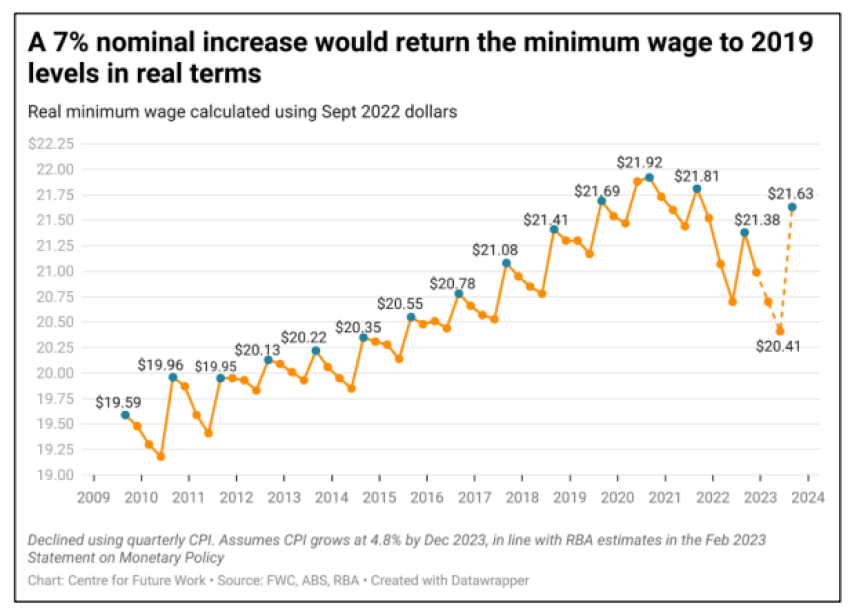
The Australia Institute (TAI) released a briefing paper on April 27 which showed the real minimum wage had fallen to 2017 levels.
The lowest-paid fifth of workers — about 3 million — are now struggling to keep up with rising costs of living. They depend on the Fair Work Commission (FWC) raising the annual minimum wage in its review in June.
The Australian Council of Trade Unions (ACTU) is calling for a 7% rise in the national minimum wage, while the biggest employer organisation, the Australian Chamber of Commerce and Industry (ACCI), wants just 3.5%.
The Labor government’s submission to the wage review does not suggest a number, but urged that the FWC “ensures the real wages of Australia’s low-paid workers do not go backwards”.
Australia’s annual inflation rate is currently at 7%, but it was 7.8% in the December quarter.
The TAI briefing paper notes that the ACTU’s proposed 7% rise in the minimum wage “would only recover part of the fall in the real value of the minimum wage in the last two years, still leaving it below the peak levels of 2020 and 2021”.
It added that an 8.4% raise would return the minimum wage to the real value it had last September, and an 11% raise would be needed to return to a pre-pandemic modest real growth trend.
But this does not tell the full story of the decline in minimum wages.
Inflation impacts more sharply on low-paid workers, because a bigger proportion of their income has to cover essentials such as housing, food, transportation and power bills.
While the headline inflation rate in the March quarter was 7%, according to the Australian Bureau of Statistics (ABS) housing (rent and mortgage repayments) was 9.8%, food 8%, electricity 15.5% and gas 26.2% (the largest on record). The cost of education also rose sharply.
Minimum wages have also fallen from 63.9% of the median wage in 1997 to 53.3% — pushing the lowest-paid workers even further behind better-paid workers, as the federal government’s submission revealed.
TAI showed that as the real incomes of low-paid workers fell back sharply during the pandemic, profits went in the opposite direction.
“Corporate profits were up almost 40% compared to 2019, the last year before the pandemic — representing an increase of $200 billion.”
Many minimum wage workers are employed in the retail industry and its bosses once again are crying poor. But TAI showed that “retail industry profit margins soared to record levels during the pandemic”.
These margins normalised by the end of 2022, as pent-up consumer demand dissipated and retail input costs grew, but they now are at or above pre-pandemic norms, it added.
Employer groups echo the Reserve Bank in warning against wage rises fuelling inflation (or even an expectation by workers that their wages will keep up with inflation). But TAI showed that rises in the real minimum rate, before it fell behind inflation in 2021 and 2022, had a negligible impact on prices.
TAI calculated that if the ACTU’s call for a 7% rise was implemented the most this could impact on prices (even assuming no productivity growth and no reduction in profits) would be a mere 0.39%.
Blaming wages for inflation is as old as the capitalist system, and it has always been a lie trotted out when workers struggle to keep up with rising costs of living.
It is a cover for the capitalists’ attempts to make working people shoulder the cost of their system’s chronic periodic economic crises.
The real causes of inflation today do not include wages, which have been falling in real terms. They do include the impact of supply shortages associated with the pandemic, the impact of pent-up demand released after the end of the pandemic, the impact of the war in Ukraine (particularly on oil prices) and the fossil fuel companies profiteering from the price shock.
Profits and Inflation in Mining and Non-Mining Sectors: More detail on the causes and consequences of the profit-price spiral, by Greg Jericho and Jim Stanford from TAI’s Centre for Future Work, revealed that 69% of excess inflation (above the Reserve Bank’s 2.5% target) was the result of “higher unit corporate profit margins”.
“By far the biggest profits were recorded in the mining sector, where corporate operating profits surged 89% since the onset of the pandemic. Those profits resulted from sky-high prices for fossil fuel energy (including petroleum products, gas and coal). Thanks to those price hikes, the mining sector now captures over half of all corporate profits in the entire Australian economy,” Jericho and Stanford wrote.
Another cause of the current inflation hike that, to date, has not been discussed publicly, is the impact of the trillions of dollars of public funds that have been used to bail out banks and other corporations in the Great Financial Crisis of 1987–88, during the pandemic and, now, in military spending which reached a global record $2.24 trillion last year.
Military spending in the Cold War was a significant contributor to stagflation in the 1970s and could well become the same today.